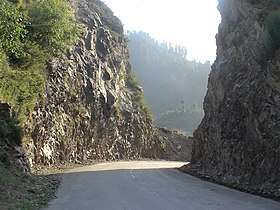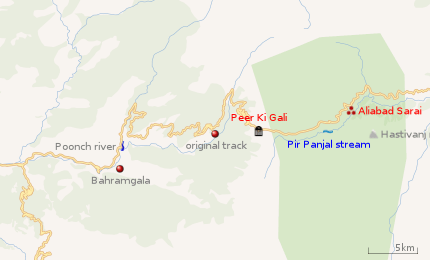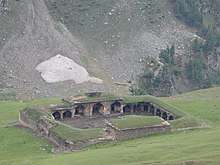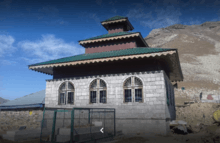Pir Panjal Pass
The Pir Panjal Pass, also called Peer Ki Gali (or Peer Gali), [1] is a mountain pass and a tourist destination, located in the Pir Panjal Range in Jammu and Kashmir. It connects the Kashmir Valley to the Rajouri and Poonch districts via the 'Mughal Road'. It is the highest point on the Mughal road at 3,490 m (11,450 ft) and lies to the south west of the Kashmir valley.[2][3]
| Pir Panjal Pass | |
|---|---|
| Peer Ki Gali | |
 Pir Panjal Pass | |
| Elevation | 3,485 m (11,434 ft) |
| Traversed by | Mughal Road |
| Location | Jammu and Kashmir, India |
| Range | Pir Panjal Range |
| Coordinates | 33.629931°N 74.519968°E |
 Location in Jammu and Kashmir, India | |
Name
The Pir Panjal Pass appears in Srivara's Rajatarangini as Panchaladeva (IAST: Pāñcāladeva), meaning the deity of Panchala. Panchala is a country mentioned in the Mahabharata in the northwest Uttar Pradesh. However, there are also traditions that place the Mahabharata regions in western Punjab and southern Kashmir. Scholar Dineshchandra Sircar has analysed the geography described in the Shakti‐sangama Tantra, where this is indeed the case.[4]
Scholar M. A. Stein states that the high mountain passes were always regarded as deities or were associated with deities. These customs continued after the region was Islamised by substituting the concept of Pir, Muslim saint, for deity.[5]
The Pir Panjal Pass gave its name to the entire mountain range (Pir Panjal Range). In recent times, the term "Panjal" has become restricted to the mountain range, and the pass came to be called simply Peer Ki Gali (the Pir's pass).[6] It is associated with the saint Nund Rishi as well as another saint Sheikh Ahmed Karim.[7]
Description
 |
Pir Panjal Pass |
The Pir Panjal Pass can be taken to run between its western entrance, which goes by the name Peer Ki Gali, and a historical way station called Aliabad Sarai at its eastern end. A stream referred to as Pir Panjal stream runs through the valley, flowing east, which becomes the Rambi Ara River in the Shopian district. Scholar Mohibbul Hassan states that the old route through the pass kept to the southern side of the stream, but the Moghuls switched it to the northern side because a steep cliff called Hastivanj to the south was difficult to cross.[8] The modern "Mughal Road" constructed between 2005–2009, keeps close to the route used by the Mughals, though it is not identical to it.
To the west of Peer Ki Gali, cliffs descend steeply into a valley, which carries another mountain stream that joins the Poonch River flowing from the north. A hill village called Bahramgala (original name: Bhairavgala) marks the end of the valley.[9] The Sikh sources name the pass itself as Bahramgala pass, in effect marking Bahramgala as is western end.[10]
The modern Mughal Road avoids the steep descent by following the hill sides to the north. It ends at a town called Bufliaz about 10 km to the west of Bahramgala. From there the National Highway 144A connects to Poonch to the northwest and Rajouri to the south.
At Peer Ki Gali, the temperature often drops as low as -7 °C or -9 °C in winter.[11] It is the highest point on Mughal Road. Peer Ki Gali is 40 km away from Shopian, 80 km from Poonch..[7][12]
History and significance
Historian Mohibbul Hasan states that the Pir Panjal Pass was one of the main passes into the Kashmir Valley and exercised a great influence on its history.[13] A route linking Hirapur (modern Hirpora) in the Kashmir Valley with Rajauri via the pass is known to have been use from ancient times. During the period of the sultans it seems to have been extended up to Bhimber.[14]
After conquering the Kashmir Valley, the emperor Akbar strengthened the route into an 'Imperial Road' stretching from Lahore to Kashmir.[8] In modern times, the route has been referred to as the 'Mughal Road'.[15]
The Sikh emperor, Maharaja Ranjit Singh, launched an invasion of the Durrani-controlled Kashmir Valley in 1814, partly via the Pir Panjal Pass. He divided the forces into two parts, one attacking via the Pir Panjal Pass under the command of Dewan Ram Dayal and the other led by himself via the Tosa Maidan. Ram Dayal forced through the Pir Panjal pass, reached Baramulla and fortified himself. However, Ranjit Singh could not break through the Durrani defences at Tosa Madian, and was forced to retreat.[16] In a second invasion in 1819, all the forces were sent via the Tosa Maidan, and conquered the Durrani forces.[17]
Aliabad Sarai

The Aliabad Sarai is a historical rest house in the Pir Panjal Pass, said to have been constructed by the Emperor Jahangir towards the end of the 16th century. It was one of the 14 halting stations constructed between Lahore and Srinagar along the Moghal Road. An Iranian engineer called Ali Mardan Khan was in charge of the construction, aided by the local chieftains. The safe keeping of the heritage building has been neglected by the government, and it has been used in recent times by local shepherds as a shed for cattle.[18][19]
The original Moghal Road passed in front of the Aliabad Sarai rest house. The current one runs behind it, at a higher elevation.
Pirs

The local tradition associates Saint Nund Rishi with the Peer Ki Gali. However, according to written records, a Pir called Sheikh Ahmed Karim, lived and meditated in the Peer Ki Gali during the time of emperor Jahangir. He is said to have converted to Islam from Hinduism. He regarded the Peer Ki Gali as a place of God and insisted that all the passers-by to treat it with reverence. The records also state that emperor Jahangir disregarded his commandments, but Shahjahan and Aurangzeb followed them.[7]
A shrine stands in the Peer Ki Gali, which marks the Pir's meditating place. A stone with his hand imprint is believed to have been placed inside it.[7]
References
- Bloeria, Sudhir S. (2000), Pakistan's Insurgency Vs India's Security: Tackling Militancy in Kashmir, Manas Publications, p. 18, ISBN 978-81-7049-116-3: "The Pir Panjal Pass also known as Pir Ki Gali, is the point over which the famous Mughal Route crosses the Range."
- Kapadia, Harish (1999), Across Peaks & Passes in Ladakh, Zanskar & East Karakoram, Indus Publishing, p. 23, ISBN 978-81-7387-100-9
- "South Kashmir: Fresh snowfall at Pir ki Gali closes Mughal road". Kashmir Reader. 1 November 2018. Archived from the original on 23 April 2019. Retrieved 14 November 2018.
- Sircar, Dineschandra (1971), Studies in the Geography of Ancient and Medieval India, Motilal Banarsidass, pp. 204–205, ISBN 978-81-208-0690-0
- Stein, Kalhana's Rajatarangini, Volume 2 (1900), note 46, pp. 397–398.
- "Snowfall hampers efforts to restore Mughal Road". India Today. 24 December 2017.
- Irfan, Shams (15 July 2014). "History and Mystery of Peer ki Gali". Kashmir Life. Archived from the original on 24 February 2020. Retrieved 19 October 2018.
- Hasan, Kashmir under the Sultans (1959), p. 24.
- Stein, Kalhana's Rajatarangini, Volume 2 (1900), p. 398.
- Gupta, The Sikh Lion of Lahore (1991), p. 125.
- "43 rescued from Zojila, Pir Ki Gali after 3 days". Daily Excelsior. 6 November 2018.
- "Peer ki Gali". J&K Tourism Development Corporation. Retrieved 21 July 2019.
- Hasan, Kashmir under the Sultans (1959), p. 22.
- Hasan, Kashmir under the Sultans (1959), pp. 23–24.
- Now, Mughal Road To Connect J&K, The Times of India, 14 July 2005.
- Gupta, The Sikh Lion of Lahore 1991, pp. 125–127.
- Gupta, The Sikh Lion of Lahore 1991, pp. 128–129.
- Tazeem Akhter, A Peek into the Aliabad Sarai, Kashmir Times, 14 October 2012.
- "District Census Handbook – Shupiyan" (PDF). censusindia.gov.in. Census of India. 2011.
Bibliography
- Gupta, Hari Ram (1991), History of the Sikhs: The Sikh lion of Lahore, Maharaja Ranjit Singh, 1799-1839, Munshiram Manoharlal
- Hasan, Mohibbul (1959), Kashmir under the Sultans, Aakar Books, pp. 43–, ISBN 978-81-87879-49-7
- Stein, M. A. (1900), Kalhana's Rajatarangini: A chronicle of the kings of Kasmir, Volume 2, Westminster: Archibald Constable and Co., ISBN 978-81-208-0370-1